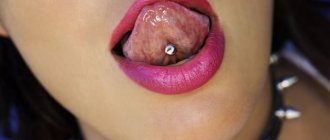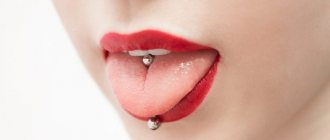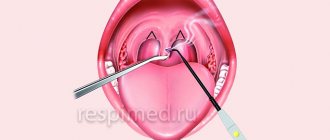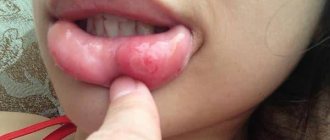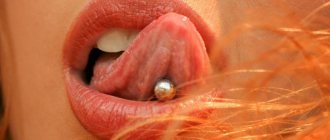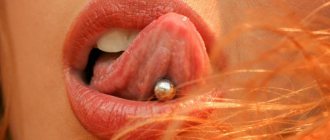Causes of infection after tongue piercing
From a medical point of view, piercing is a procedure associated with violating the integrity of the skin (invasive). And, like many other similar procedures, it can cause a variety of consequences. The following problems are typical for oral piercings:
- allergy to the material from which the jewelry is made, or to the drug that was used to treat the puncture site;
- formation of scars;
- chronic injury to teeth and mucous membranes;
- increased salivation (hypersalivation);
- development of infection and, as a consequence, inflammation [1].
Infection of a puncture site in the oral cavity occurs mainly for two reasons:
- After the procedure, the wound is not cared for or care is carried out incorrectly or irregularly.
- The biological balance in the oral cavity is disrupted due to the constant locally irritating effect of decoration.
In the oral cavity, a microbiome is formed and exists in a more or less constant quantitative and qualitative composition. This is a collection of microorganisms that normally (when there are no inflammations or other provoking factors) are in biological balance. This means that opportunistic microorganisms are not activated and do not lead to infection, because there are no prerequisites for this [2].
Only with the advent of molecular genetic research methods did the study of the biology of microorganisms (microbiome) truly begin as one of the leading triggers for the development and progression of inflammatory diseases of the dental system.
They inhabit the mucous membranes, the back of the tongue, the gingival sulcus, oral fluid and dental plaque, receiving the necessary proteins, carbohydrates, amino acids, inorganic and other substances from the oral fluid. Occupying only 0.03–0.05 m² of oral cavity area, the microbiome of this ecological niche includes representatives from 530 to 700 stable species. Katola V.M., Ph.D., leading researcher at the Institute of Geology and Environmental Management, Far Eastern Branch of the Russian Academy of Sciences [2]
Some microorganisms play a positive role in the health of the oral cavity, mucous membranes, and teeth. Thus, bifidobacteria, in the course of their life activity, help to increase local immunity in the mouth, suppress the development of pathogenic flora, and reduce the likelihood of developing caries. At the same time, streptococci, actinomycetes and other microorganisms increase the level of acids, which over time dissolve tooth enamel, which increases the sensitivity of teeth, decreases their mineral density (primarily due to the destruction of calcium and fluoride), and inflammation of periodontal tissues develops. which hold the tooth in the socket [2].
Tongue piercing as an injury and jewelry that is inserted into the hole changes the biochemical balance of the environment inside the oral cavity. The protective properties of saliva, the rate of its secretion and the activity of enzymes change, the hygienic condition of the oral cavity and teeth deteriorates, the mechanism of chewing and articulation changes. All this, in combination with other factors, leads to the creation of conditions under which “bad” bacteria, that is, opportunistic bacteria, multiply more actively. Microbes easily settle on the inflamed tissue at the puncture site, multiply and cause an infectious process. Most often, after tongue piercing, infection is associated with various pathogens: Actinomyces, Campylobacter, Neisseria, Streptococcus, Candida fungi and others [3, 4]
What to Avoid While Your Tongue Heals
What to avoid:
- Hard, sour, sticky, spicy foods.
- Talk too much.
- Kissing and any other use of the mouth with girlfriends/friends
- Putting foreign objects in your mouth.
- Smoking (it’s better to abstain at first, and once the piercing heals, then quit smoking altogether)
- Experiment with tongue decoration (you will have plenty of time for this after healing)
The swelling should go down in a couple of weeks, but the healing period may take longer.
Once pierced, the tongue usually takes three to four weeks to completely heal. This is one of the fastest-healing piercings as the enzymes in saliva help fight infection and kill bacteria.
This is interesting: How to painlessly stretch ears with sensors
You will need to use a good non-alcoholic mouthwash to help clean your mouth, but be careful not to over-clean, which can cause your tongue to turn green or brown. If this happens, simply reduce the amount of mouthwash you use and how often you use it.
- Days 1-5: After the first day, you will experience bloating. This will be worse during the first five days, when your speech will be impaired and you may have to change your diet to mashed potatoes, noodles, and other soft foods. Drinking cold drinks helps. For faster healing, you should avoid drinking alcohol or hot drinks, smoking, kissing, fiddling with or even touching a barbell, and ibuprofen and aspirin (which can increase swelling—use Tylenol instead).
- Days 5-7: The swelling will begin to decrease. Some people recover faster than others.
- Days 7-10: Swelling should go down now. When this happens, you need to have the bar replaced with a shorter one. The day you can replace the long barbell with a shorter one will depend on the amount of swelling you experience.
- Day 10-28: It may take 3 to 4 weeks to heal completely.
When can I remove the jewelry from my tongue and for how long?
The answer to this question varies from person to person. Tongues heal quickly, and even if the piercing is technically healed, it will also heal and close if you leave the jewelry out for an extended period. Some piercings can heal closed almost immediately in a day or two, while others with established piercings say they can go without jewelry for up to three weeks, don't worry.
This is interesting: Long list of navel piercing problems
Typical symptoms after piercing
Of course, not every piercing leads to infection, but some vigilance is needed. A tongue piercing is an injury, and it heals in the same stages as other injuries. This stage lasts, according to various sources, up to 10–14 days. Typical complaints and symptoms after piercing are:
- swelling;
- pain or discomfort in the puncture area;
- feeling of tightness, numbness of the tongue;
- tingling, burning, especially when food, drinks, or medications come into contact with the wound;
- discharge of a small amount of blood or yellowish serous fluid [1, 4].
Installed jewelry can be a factor of permanent trauma, and this leads to chronic low-grade inflammation, in which there is minor local swelling and slight redness due to disruption of the integrity of the epithelium.
History of piercing
The most popular area for piercing is the earlobe, other popular areas are the ear cartilage, eyebrow, nose, tongue, lips, navel, nipples and genitals. Piercing is one of the most fashionable trends in decorating the face and body today. This phenomenon has existed throughout human history. The history of piercing began with the rituals of tribal peoples. For example, the Indians even pierced the nasal septum, and in Africa a pierced tongue meant belonging to a certain tribe; in Ancient Egypt, body jewelry was considered a privilege of the upper class and priests.
Possible signs of infection
If an infection is added to post-traumatic inflammation, local and general symptoms of infection occur. Their appearance is associated with a protective reaction at the local and general level of the body in response to chronic inflammation and changes in the microbial composition in the oral cavity. Accordingly, there are differences between local (in the oral cavity and on nearby tissues) and general manifestations of the infectious-inflammatory process associated with a cascade of reactions to the pathological process. These symptoms can appear at any time.
Local symptoms include:
- increased pain;
- the appearance of a twitching pain that can spread (give) to the ear, nose, submandibular area, and head;
- the tongue “tastes” hot, a change in its relief occurs;
- increased swelling;
- in the mirror you can see redness, sometimes whitish films, veins of blood vessels;
- the appearance of cloudy discharge, possibly with an unpleasant taste and odor [4].
General symptoms:
- increased body temperature;
- chills;
- body aches;
- decreased appetite;
- increased fatigue;
- enlargement of local lymph nodes (on the neck, on the back of the head, behind the ears) [4].
How to prevent infection
There are many reasons for the development of infection after piercing, and they are not always associated with non-compliance with aseptic and antiseptic methods during puncture. But given the invasiveness of the procedure, you need to carefully choose a salon for piercing, focusing on the recommendations of Rospotrebnadzor. The main points of infection prevention are simple [5]:
- Do not carry out procedures during acute illness (colds, indigestion, herpes rashes, etc.) or during exacerbation of chronic diseases.
- Perform piercing only in a certified center, where the sterility of the instruments and the puncture process is maintained.
- Follow the recommendations for caring for the postoperative wound.
- Take regular and proper oral care [1, 4].
FAQ
Is it possible to get a nose piercing wet?
On the first day after the session, do not allow tap water to come into contact with the puncture. On other days, standard hygiene procedures (washing, hair washing) can be carried out as usual.
Can I treat my piercing with hydrogen peroxide?
Hydrogen peroxide does not have antiseptic or healing properties. It dries and even burns the skin. Therefore, its use is not recommended.
Is it possible to drink before a piercing?
Alcoholic beverages should not be consumed the day before the session, on the day of the procedure and 2-3 days after it.
Non-dental infections after piercing
Like any injury, piercing reduces the body's defenses. At this time, dormant infections outside the oral cavity may become active and cause an acute process. If hygienic requirements, asepsis and antiseptics are not observed during piercing, there is a risk of contracting infections transmitted by “blood”, blood transfusion, when poorly treated instruments or hands, on which particles of infected blood of a sick visitor to the piercing salon remain, the infection enters the blood of a healthy one. This is how HIV, tetanus, and hepatitis are transmitted [1].
Piercing: contraindications
Before the procedure, the specialist must find out the following risk factors:
- The presence of chronic skin diseases,
- decompensated cardiovascular conditions,
- any degree of renal failure,
- oncological diseases,
- allergic diseases, bronchial asthma.
- age less than 18 years,
- infectious diseases (acute and chronic),
- diabetes, other endocrine diseases
- tendency to form keloid and hypertrophic scars,
- what medications you are taking or plan to take,
- do you smoke,
- Do you often sunbathe?
- How active are you in sports?
Depending on the area of the piercing, the correctly chosen shape, size, diameter and weight of the jewelry are also important. All threaded or press-fit jewelry must have internal threads (posts should not have threads). Most often, “bars”, “labrets”, “rings”, “circulars”, “microbananas”, “plugs”, “nostrils”, “spirals”, “clusters” are installed.
A wide selection of jewelry allows the patient to choose the right option for himself. There are both simple decorations and those with twists in the form of various shapes. Often jewelry can be inlaid with semi-precious and precious stones.
Types of piercing:
Non-infectious problems after piercing
Reactions to piercings are unpredictable and varied, but it is impossible to predict whether a particular patient will have them or not and what they will be. You should remember the risk of problems that are not related to the infectious-inflammatory process, but that affect the functioning of the dentofacial apparatus and the patient’s dental health. Piercing can provoke allergic reactions, periodontopathies, defects in hard dental tissues, tongue abscess, hypersalivation, impaired diction, galvanism, and scar formation [4].
How long does it take for a lip piercing to heal?
In this area, recovery takes 1.5-2 months. After just 2 weeks, the swelling subsides, the redness goes away, a crust appears and the discharge stops. Treating the wound with antiseptics will help speed up the healing of your lip piercing. The main thing is not to remove the jewelry, even during the period of care procedures.
During recovery, you should avoid drinking alcohol, eating spicy foods, and quit smoking.
Treatment of an infected tongue
If you experience complaints similar to an infection, you should consult a doctor to diagnose the causes and determine treatment tactics. It consists of removing decorative piercings (sometimes replacing them with silicone ones), antiseptic treatment, and prescribing local and systemic antibiotics. If necessary, the wound is drained, sometimes surgical excision is performed, followed by closure of the defect. It must be remembered that chronic trauma to the tongue due to piercing can lead to malignancy—cancerous degeneration [4].
How long does it take for an eyebrow piercing to heal?
Complete regeneration of the skin in the eyebrow area takes from 2 to 3 months. To avoid complications, during the healing period of the eyebrow piercing it is necessary to treat the wound with antiseptic agents and carefully remove the discharge with a cotton pad. The earring must be moved very carefully so as not to damage the recovering skin.
Experts do not recommend sleeping on the side on which the puncture is located. It is also important to change your pillowcase daily while there is still discharge. This will help avoid infection.
